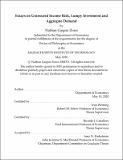| dc.contributor.advisor | Iván Werning and Ricardo J. Caballero. | en_US |
| dc.contributor.author | Zorzi, Nathan Gaspar. | en_US |
| dc.contributor.other | Massachusetts Institute of Technology. Department of Economics. | en_US |
| dc.date.accessioned | 2020-09-03T17:41:04Z | |
| dc.date.available | 2020-09-03T17:41:04Z | |
| dc.date.copyright | 2020 | en_US |
| dc.date.issued | 2020 | en_US |
| dc.identifier.uri | https://hdl.handle.net/1721.1/126996 | |
| dc.description | Thesis: Ph. D., Massachusetts Institute of Technology, Department of Economics, May, 2020 | en_US |
| dc.description | Cataloged from the official PDF of thesis. | en_US |
| dc.description | Includes bibliographical references. | en_US |
| dc.description.abstract | This thesis consists of three chapters on uninsured income risk, lumpy investment and aggregate demand. The first chapter analyzes the non-linear response of durable spending to income shocks. Empirically, the average marginal propensity to spend (MPC) on durable goods increases with the size of income changes. I investigate whether a canonical model of lumpy durable investment with incomplete markets can replicate this fact. I first clarify analytically the source of non-linearity in this model, and I show that its sign depends on the relative strength of the extensive and intensive margins of durable adjustment. In numerical exercises, I find that the extensive margin dominates quantitatively, so that the model generates the form of non-linearity observed in the data. However, the magnitudes predicted by this canonical model are substantially lower than their empirical counterparts. I suggest various avenues to improve the quantitative performance of the model. | en_US |
| dc.description.abstract | The second chapter investigates the general equilibrium implications of this form of nonlinearity. I recognize that durable spending is strongly pro-cyclical, that workers employed in durable sectors have a more cyclical labor income than those employed in nondurable sectors, and that workers are imperfectly insured against these fluctuations. In turn, the average MPC on durables increases with income changes, so that this redistribution of labor incomes across sectors has aggregate effects. To formalize and quantify this mechansim, I develop a heterogeneous agent New Keynesian (HANK) model with multiple sectors and lumpy durable adjustment. There is no labor mobility between sectors and financial markets are incomplete, so that durable workers are more exposed to aggregate shocks. I first show analytically that the interaction between cyclical investment and redistribution amplifies the aggregate response of durable spending during booms and dampens it during recessions. | en_US |
| dc.description.abstract | I then quantify the importance of this mechanism using my structural model. The third chapter focuses on the cyclical reallocation of workers across sectors or occupations. Specifically, I explore how uninsured income risk and liquidity frictions can hinder the efficient matching between workers and occupations. I investigate this question in a continuous-time Lucas-Prescott economy with incomplete markets. In this setting, uninsured income risk induces labor misallocation across occupations through two channels. First, it reduces workers' incentives to search (ex ante) for an occupation where they have a strong comparative advantage. Second, it induces excess separation (ex post) by forcing productive households to leave their occupation when their liquidity buffers are depleted. In general equilibrium, labor misallocation exacerbates endogeneously the effect of uninsured income risk, by depressing the value of equity that workers use as liquidity buffers | en_US |
| dc.description.statementofresponsibility | by Nathan Gaspar Zorzi. | en_US |
| dc.description.tableofcontents | 1. Lumpy Investment and the Non-Linear Response to Income Shocks -- Appendix to Chapter 1 -- References to Chapter 1 -- 2. Investment Dynamics and Cyclical Redistribution -- Appendix to Chapter 2 -- References to Chapter 2 -- 3. Uninsured Income Risk and Labor Misallocation -- Appendix to Chapter 3 -- References to Chapter 3. | en_US |
| dc.format.extent | 145 pages | en_US |
| dc.language.iso | eng | en_US |
| dc.publisher | Massachusetts Institute of Technology | en_US |
| dc.rights | MIT theses may be protected by copyright. Please reuse MIT thesis content according to the MIT Libraries Permissions Policy, which is available through the URL provided. | en_US |
| dc.rights.uri | http://dspace.mit.edu/handle/1721.1/7582 | en_US |
| dc.subject | Economics. | en_US |
| dc.title | Essays on uninsured income risk, lumpy investment and aggregate demand | en_US |
| dc.type | Thesis | en_US |
| dc.description.degree | Ph. D. | en_US |
| dc.contributor.department | Massachusetts Institute of Technology. Department of Economics | en_US |
| dc.identifier.oclc | 1191226824 | en_US |
| dc.description.collection | Ph.D. Massachusetts Institute of Technology, Department of Economics | en_US |
| dspace.imported | 2020-09-03T17:41:03Z | en_US |
| mit.thesis.degree | Doctoral | en_US |
| mit.thesis.department | Econ | en_US |
